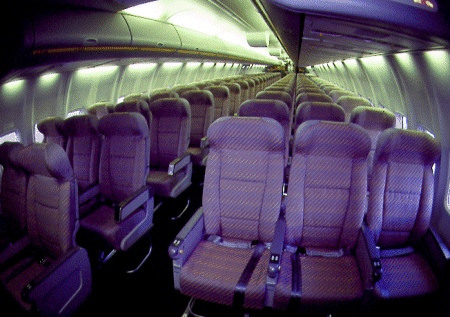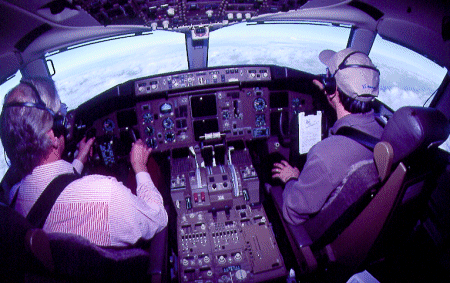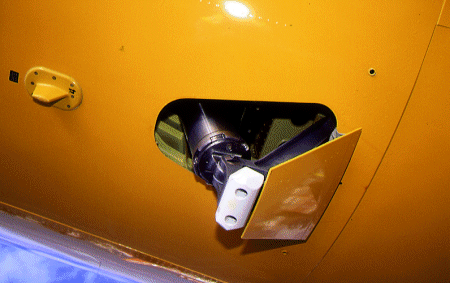Flight International flight tests Boeing's latest 757 model, the stretched 240-seat -300 which entered service last March
Peter Henley/LUTON

One of Boeing's marketing slogans is that it has a family of airliners for every market. The 757 and 767 family members are intended to complement one another in range and capacity.
The single-aisle 757family operates at ranges of 6,410-7,250km (3,465-3,920nm) respectively, while the widebody 767 models are in the 9,250-13,000km bracket. Together, they are Boeing's offering for the 180-300-seater market, sitting between the 737 and 777 families.
Despite the different cabin sizes and weights, the two types are aerodynamically similar and share handling and performance qualities. Both were certificated to the same US Federal Aviation Regulations (FARs). Both share flightdeck design, avionics, air conditioning and auxiliary power units (APUs). Pilots can fly both with a common type rating.
Launched in 1996, the stretched 757-300 has almost a year of revenue operations under its belt with launch customer Condor Flugdienst, who put the new model into service last March. Compared to its stablemate, the aircraft is stretched by 7.1m (23.3ft), boosting typical two-class capacity by 20% to 243 passengers, while cargo volume is up by 50%. The stretch makes the 757-300 the world's longest single-aisle twinjet: the four-engined McDonnell Douglas DC-8 Series 60/70 is the only longer narrowbody.

Customers pressured for the changes built into the -300 to be as transparent as possible to the pilots. There are considerable economic advantages in maintaining a common pilot type-rating. As a result, the flightdeck is distinctly dated when compared with, say, an Airbus A320 or A330/A340 or the in-house 777 family.
For the same reasons, the temptation to update aircraft systems has to be resisted if the consequent system operation by the pilot would be significantly different from the earlier aircraft. An obvious example is the retention of the 757-200's electronic engine control (EEC - on Rolls-Royce RB211-powered versions), rather than the adoption of the more sophisticated, full-authority digital engine control (FADEC) available on the PW2000-powered version. That the 757-300 remains a delight to fly says much for Boeing's competence at technological compromise.
The aircraft offered to Flight International for a flight evaluation was a production RB211-powered 757-300 (D-ABOI) destined to be the eighth -300 delivered to Condor. It has been leased by Boeing prior to delivery for a world demonstration tour.

The cockpit is classic Boeing. There are typical control yokes, with two-pole pitch trim thumb switches, a rocking transmit/intercom trigger switch behind the outboard hand grip, and a brief checklist panel at the yoke's centre. The field of view is good and the seat comfortable, with a five-point harness and mechanical adjustment for reach, height, recline and arm rest position. As the seat runs backwards, the rails turn outboard, increasing the gap between the seat and the centre console, making entry and exit easier. The rudder pedals are adjustable for reach via a small cranked handle between the pilot's knees. There is plenty of elbow room, a large floor area for flight bags outboard of each seat, and each cockpit side wall has plentiful document storage built in. The large side windows can be opened and an emergency escape rope is stowed in the roof above.
Generally the cockpit seems a comfortable and congenial working environment. Compared to the state of the art in glass cockpits, it is, however, noticeably "busy" and verges on the cluttered. The roof panel is extensive, housing systems control panels equipped with conventional switches, indicators and mimic diagrams. Behind these are roof panels of circuit breakers. The centre console between the pilots includes a quadrant containing the power levers, flap lever and airbrake (speed brake) lever. Behind these is a broad plateau of communication and navigation control boxes. Immediately above the forward end of the console, on the centre instrument panel are two cathode ray tubes (CRT), one above the other, used for engine indicators and systems synopsis displays.
Perhaps the most obvious concession to commonality with the 757-200 lies in the pilots' instrument panels. They are equipped with early-technology electronic flight instrument system (EFIS) displays. Each pilot has two CRTs mounted verically, with the upper one providing an electronic attitude director indicator (EADI) display and the lower one the electronic horizontal situation indicator (EHSI) presentations. The CRTs are complemented by mechanical (round dial) altimeters, airspeed indicators (ASIs) and vertical speed indicators.
Simple engine start
The pilot in command was 757 chief project pilot Leon Robert. I took the left-hand seat and engineering pilot Capt Suzanne Darcy occupied the jump seat. Starting the 757's RB211 turbofans, after pushback from the stand, was straightforward. Bleed air for engine start comes from the Honeywell (formerly AlliedSignal) GTCP331-200 APU mounted in the tailcone. This unit also provides electrical power and air conditioning on the ground, can be started in the air up to 43,100ft (13,100m) and can supply bleed air up to 17,500ft.
The engine indication and crew alerting system (EICAS) displays on the central upper CRT show engine pressure ratio (EPR), fan speed (N1), intermediate rotor speed (N2) and the high-pressure rotor speed (N3), plus oil temperature, pressure and quantity. The start panel in the roof has a rotary ignition switch for each engine on which the mode required is selected (GND, FLT, AUTO or CONT) and an engine start switch to select left, right or both engines. During engine acceleration, the pilot introduces fuel via a control switch on the quadrant behind the power levers. The EICAS indicates any start malfunction, requiring the pilot to shut down the engine. The engine-start system is simple, but not as effortless as with a FADEC system which would provide automatic start sequences and start abort.
Taxiing the -300 is a pleasure. The nosewheel steering (on the captain's side only on this aircraft) is via a tiller arm conveniently to hand, outboard of the pilot's left thigh. The toe-operated carbon-disc brakes are smooth, progressive and powerful. The handbrake is a T-lever on the captain's side of the centre console; once the brakes have been applied by the foot pedals, they are locked on by raising the handle - and released by pressing the pedals and lowering the handle.
The fuselage stretch of the -300 has given it a long-wheelbase undercarriage. Allowance has to be made for the distance of the cockpit ahead of the mainwheels and nosewheels, and the fact that the nose and main wheels follow markedly different paths during a tight turn. The taxiway to runway 26 at Luton does not go as far as the threshold, necessitating a backtrack and 180° turn before take-off. The minimum pavement width for a 180° turn is 43m (141ft) and the runway width 45m, with a little extra provided by the small turning circle at the threshold. By following Robert's precise directions, it was relatively easy to complete the turn starting from a walking pace with a trickle of symmetrical engine power, full nosewheel deflection and no differential brake. Despite the cockpit's height above the ground, it was not difficult to judge taxi speed. If in doubt, or at night, the speed could be determined from a GS [ground speed] display on the EADI.
The weather for take-off was light rain from broken cloud cover and a surface wind of 16kt. The runway surface was wet and the temperature +7°C. The all-up weight was 101,700kg, against the maximum permitted 122,470kg with 33,500kg of fuel. There are three take-off flap positions (5, 15 and 20); for the prevailing conditions of 2,160m runway length, field elevation of 150m and aircraft weight, take-off flap 20 was appropriate.
The conditions also dictated a full power take-off. The EEC simplifies thrust management and, on this occasion, auto throttle was used. The reference speeds were available on a placard and the bugs on the ASI were set against V1/134kt, Vr/151kt and V2/160kt. The aircraft was held against the wheel brakes, the power levers were set to about 1.1 EPR, the thrust switch was pressed and the brakes released. The power levers moved automatically to the full power position and the aircraft was kept straight, with rudder pedal steering of the nose wheels until the rudder became effective at about 50kt. Acceleration was brisk and smooth, and rotation forces pleasant. A gentle rotation was required to establish an unstick (lift-off) attitude of about 7.5°, as the flight director pitch command cannot be used on take-off. The shallow unstick attitude is essential to avoid tail contact with the runway - another consequence of the fuselage stretch. The tail clearance at 7.5° pitch attitude, with all take-off flap settings, is only 66cm. Aft fuselage contact with the runway would occur at 9.5° pitch attitude with mainwheels on the runway and the undercarriage legs extended. This tender area of 757-300 handling has led to the -300 being fitted with a retractable tailskid (below), which provides a TAILSTRIKE crew alert in case of runway contact.

After take-off, the flight director could be used as the pitch reference, with cross reference to indicated airspeed. Initially, the pitch demand was about 15°, resulting in a climb speed of 175kt (V2+15kt), which was maintained to flap retraction altitude at 1,000ft above field elevation. Here, the aircraft was accelerated and the flap retracted incrementally with flap-up achieved by about 3,000ft. This aircraft had a speed tape indicator at the left edge of the EADI (in addition to the round-dial ASI), which had useful markers for the initiation of flap retraction. Retracting the undercarriage, as soon as the aircraft was safely airborne, and flap retraction, during the clean-up acceleration, caused no discernable pitch change.
Flying controls in tune
The wing high-lift devices comprise a flap and slat system consisting of leading-edge slats and four double-slotted trailing-edge flaps, all hydraulically operated with emergency electric motor back-up. The slats have three positions: take-off, cruise and landing. In take-off position, the slats remain in contact with the wing leading edge, but open to form a gap in the landing positions. If a stall is detected with the flaps set to a take-off position, the slats automatically open to the gapped setting to augment lift until airspeed increased.
The climb to 35,000ft was progressively cleared by ATC, making the workload a little higher than in an unrestricted climb. Despite distractions, it quickly became apparent that the757-300 has well-harmonised primary flying controls, mechanical and hydraulic in operation and including artificial feel and centring. Roll control is by ailerons and six spoiler panels on each wing, which also serve as airbrakes when symmetrically deployed. Co-ordination between the ailerons and spoilers was good and provided smooth and seamless forces in roll. Roll acceleration and rate of roll were impressive for this class of aircraft.
Pitch control is via conventional elevators and the moveable (variable incidence) horizontal stabiliser provides longitudinal trim through the control column trim switches. The 757-300 has good natural longitudinal damping; a disturbance of the elevators by a stick slap (pitch bump) at 309kt in the climb produced dead beat, or immediate, damping. It was equally nice directionally, a rudder doublet, also at 309kt, being dampered in 1½ cycles with both yaw dampers off and in half a cycle with them on.
The maximum cruise level would have been 37,000ft at the prevailing aircraft weight. At35,000ft the aircraft was levelled and accelerated beyond the "book" cruise mach number of M0.80 to the VMO of 0.84. Here it was possible to provoke slight mach buffet by applying a little g in straight and level flight but there was no tendency to pitch nose down (Mach tuck), and a 35° bank turn to the right resulted in a little buffet at M0.83. The aircraft's handling remained commendably crisp at this level and clearly, there are good buffet boundaries for normal operations.
A descent was then started. At Mach 0.824/285kt, passing through 34,400ft and with some power still on the engines, the airbrakes were smoothly deployed, taking 5s to move the selector lever through the gate. There was some aerodynamic burble, but little pitch change. Subsequent selection of airbrakes, power off, produced the same results.
The 5min carcase cooling time required for airborne premeditated engine shutdown was started, the flight director turned off and manual throttle selected. Boeing standard procedures were followed to start the APU and shut down the port engine. Although at 17,500ft, a windmill relight (flight start) would have been well within the envelope (maximum level 29,000ft), I elected to try a cross-bleed relight after some single engine handling.

Throughout the handling phase of this flight we had used a block of airspace centred on the Wash and extending to Skegness to the north and Cromer to the east., with help from London Military Radar's information service. This allowed great freedom to manoeuvre, further exploited on one engine. Altitude of 17,000ft and thereabouts was higher than ideal to sample single-engined handling, but the broken cloud cover beneath precluded lower levels. With the port engine shut down and the starboard at full power, the aircraft was easy to trim and pleasant to fly, clean, at 200kt. Turns into the dead engine and rolls from 30° of bank to 30° opposite bank were reassuring. Reducing speed to the stick shake in a climb caused no drama and the untrimmed foot forces were not hard to hold.
The port engine was re-lit using bleed air from the live engine; the start took 5s and the maximum exhaust gas temperature was 350°C - a good start. A 5min engine-warming period then had to be observed at flight idle before power could be applied. Meanwhile, the aircraft was prepared for a couple of stalls, including the selection of continuous ignition on the engines.
The first stall was clean, power off and speed was reduced at 1kt/s from the trim speed. Stick shake occurred at 178kt and buffet onset was at 165kt. The stall was defined by heavy buffet. There was no g break nor any tendency to roll or slice during the stall; the minimum speed seen was 152kt. The second stall was with the undercarriage down and the aircraft configured with flap 30. The same technique was used and stick shake was at 110kt and buffet onset at 104kt. Again, the stall was defined by heavy buffet and there was no g break or tendency to roll or slice.
Three functions automatically occur in the 757-300 during the approach to the stall: the stall warning computers trigger the extension of the leading-edge slats; the windshear detection system displays a pitch limit indicator (primarily for windshear guidance) on the EADI and a feel and centring unit in the tailplane shifts the neutral position of the elevators to increase nose down pitch authority.
Return to Luton
In summary, the 757-300 is a safe aircraft at and near the stall. With the middle airwork completed, the recovery to Luton was planned. The autopilot was engaged, engine anti-icing selected on and rough air speed (VRA) - 290kt - scheduled because of the light-to-moderate turbulence) Flight Level Change (FLCH) mode and auto throttle were selected; cleared levels or altitudes in the descent were set in the altitude window and the aeroplane did the rest, navigating by global positioning system.
The EHSI was In MAP mode (with weather and traffic overlays) and clearly showed waypoints, but the display's lower half was obscured by the boss of the control yoke. It was necessary to lean forward, away from the normal eye position, to see the full display. The 757-300 is the first Boeing derivative model to incorporate Honeywell's enhanced ground proximity warning system, which is displayed on the EHSI. Rockwell Collins' predictive windshear radar is also incorporated into the displays.
At about 28km (15nm) range, Luton Approach offered radar vectors to marshal the aircraft for the instrument landing system to runway 26. The EHSI display was changed to Expanded ILS Mode, with weather and traffic, and the localiser captive mode button pressed. Capture of the localiser was smooth, with no overshoot, from about a 300° closing track.
Throughout the auto-flight the aircraft manoeuvred smoothly and precisely, mode selections were easily made and could be readily monitored by the other pilot. The EFIS displays were clear (apart from the portion of the EHSI obscured by the yoke) and crew situational awareness was good. There was, however, in areas of turbulence (much of which was moderate), a tendency for the aircraft to fishtail. Robert explained that the yaw damper function has an "algorithmic modal suppression" so as to damp lateral motion aft, but the effect could still be detected on the flightdeck.
The prelanding checks were completed, as usual, before glideslope capture, and the aircraft settled nicely on the glide slope at a VAT (VREF) of 143kt. The autopilot and autothrottle were then disengaged so that I could fly the final 1,000ft of the approach and land. Once again, the pitch attitude of the stretched 757 is crucial in the round out, or flare, to avoid scraping the tail skid. I would have liked a visual circuit(traffic pattern), but time had run out as the 757-300 was due to leave for Amsterdam.
Flying the aircraft was enjoyable. It perpetuates the Boeing tradition of proven conventional design with endearing handling qualities and a cockpit working environment which would make any experienced Boeing pilot feel at home.
Source: Flight International


























